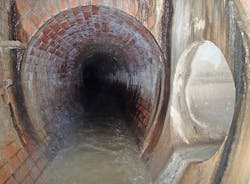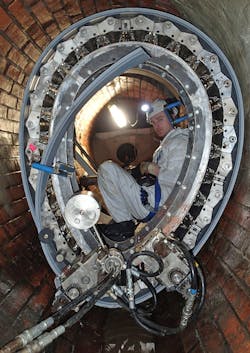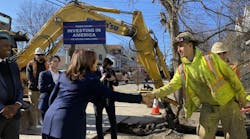The city of Ansbach and the wastewater treatment company Abwasserentsorgung Ansbach AöR have prepared the underground infrastructure of the city for the future in a five-year long major renewal project. As part of this work, a trenchless Spiral-Wound rehabilitation technology had to fulfill challenging construction site conditions.
By Katy Rademacher
Since June 2011 extensive construction work has been carried out above and below ground on the 530m long historical promenade in the centre of Ansbach, Germany. The promenade of the city, which has 40,000 inhabitants, is lined with multi-storey houses built in the Franconian Rococo style. The aim of this major construction project is to prepare the wastewater network, channelled rivers and the supply lines for gas, electricity and water under the busy promenade for the increasing demand.
The city of Ansbach, the Ansbach municipal utilities and the wastewater treatment company Abwasserentsorgung Ansbach AöR (awean) are carrying out the five-year project in collaboration with numerous partner companies.
Companies working on the site have been the pipe jacking firm for the storage sewer at 8 m depth, the civil engineering firm for the renewal of the arched river conduit as a rectangular-shaped profile, the sewer rehabilitation company and others.
A sub-project on this major construction site was the trenchless rehabilitation of a combined wastewater sewer with diameters of 1200 x 1550 mm. The egg-shaped brick sewer, which is approximately 90 years old had groundwater infiltration of varying severities. It was rehabilitated by using the SPR Spiral-Wound method, which is especially for custom-shaped profiles, in two construction phases: 220m from May to August 2013 and the remaining 140m from August to October 2014.
Difficult construction site conditions
As the rehabilitation of the combined wastewater sewer was a sub-project and its position is 4m under the promenade, the conditions and requirement criteria for this project were difficult. Moreover, the promenade is lined with listed buildings from the era when Ansbach was governed by margraves, dating as early as the 15th Century, and thus some of the buildings are built on posts made of oak or pine wood. This type of foundation was necessary because several rivers, which are now partly channelled underground, wind their way through Ansbach. The adjacent buildings are only about 4 - 5m from the sewer that was rehabilitated.
There have already been problems with high groundwater during excavation work in the Ansbach city centre in the past. Because the groundwater level stands at about 1.8 - 2.5m below ground level and some buildings have wooden foundation posts, it is not possible to lower the groundwater table in the long-run without causing irreversible damage to the buildings. This meant that awean focused on the trenchless rehabilitation system of Sekisue SPR.
Spiral-Wound method
The Spiral-Wound pipe system SPR used in Ansbach is based on the principle of the mechanical in-situ production of a liner made of steel-reinforced PVC-U profile strips. The method, which was developed especially for custom-shaped profiles in large diameters, produces Spiral-Wound liners for diameters of 800 to 5500mm.
The winding machine is inserted in the rehabilitation section via a standard manhole, assembled directly in the host pipe and adjusted to the diameter and shape of the special profile.
The winding process leaves a defined annular space between the Spiral-Wound pipe and the host pipe, which is then filled with a high-strength grout. The grouting provides the Spiral-Wound pipe liner with its static stability, which is equivalent to a new pipe. The thickness of the annular space is determined regarding to the required static properties. The winding process can take place under live flow condition. This means, the sewer, residential connections and inlets from the neighbouring streets can remain in operation during the rehabilitation process.
Trenchless rehabilitation
Before starting the rehabilitation work, it was essential to repair the infiltration in the 360m long sewer section and repair the manholes beforehand.
The egg-shaped profile was rehabilitated during controlled live flow by winding a steel-reinforced SPR profile strip into a new watertight liner directly in the host pipe. With every rotation the Spiral-Wound pipe machine moved with the growing Spiral-Wound pipe to the end point.
The complete installation length of both construction sections, 360m, could be wound in one go without interruption. The 19 Spiral-Wound pipe spools stationed in a row above ground supplied the winding machine continuously with profile strip via the standard manhole. The winding machine locked the 19,000m of profile strips with a tongue-and-groove mechanism to create a resistant liner.
Once one of the 19 Spiral-Wound pipe spools was used up, a new profile strip was butt welded in the winding machine. The Spiral-Wound pipe liner was installed with a wall thickness of 16.3mm and an annular space of 67.4 mm along the 360m long rehabilitation section. This reduces the drain cross section which is compensated for during operation by the improved hydraulics. In addition, the combined wastewater sewer now branches into a new deep-set storage sewer that was built at the same time.
The new liner got its static characteristics from the subsequent grouting of the annular space. For this the bracing was installed in the fully wound liner. The bracing units positioned the Spiral-Wound pipe according to the static requirements and thus prevented buoyancy, a position shift and deformation during the grouting process. Around 140 cubic metres of a special high-strength grout was inserted in several applications into the annular space, which was precisely calculated with the static properties in mind.
After the on-site rehabilitation work, which lasted five months in total, the pipe section was connected to the sewer by classic manhole rehabilitation and the inlets and residential connections were reattached with ombran flex and wastewater pipe connection pieces. Only a minimal level of noise, dust and exhaust fumes was produced during the trenchless rehabilitation.
Emissions burden
In the five month rehabilitation phase 360m of underground combined wastewater sewers were repaired under live flow conditions and with no necessary drainage.
Meanwhile, there were hardly any disruptions for the residents or the other construction companies working on the site. The sewer was only accessed via pre-existing inspection manholes. The construction time was shortened by at least 50% due to the omission of excavation work and the reconstruction of the area as well as the rehabilitation process could be arranged flexible.
Most of the energy expenditure results from operating the hydraulic winding machine via a mobile, low-noise generator with an output of approximately 50 kVA. By using the Spiral-Wound method it was possible to cut transport costs by around 90% and costs for machinery operation by 75% in comparison with open trench construction.
This not only eliminated a large share of the total expenses which would have been associated with earth removal, open-cut road works and subsequent reconstruction, but also left the soil conditions unchanged, the wetland area around the historical buildings and the roots of the trees untouched.
All construction site related necessary requirements as well as the wished reduced emissions burden were fulfilled to awean's full satisfaction. For the many cities that are forced to observe particulate matter limits, trenchless rehabilitation is a good way to lower carbon-particulate emissions.
Dipl. Ing. / Wirt. Ing. Katy Rademacher is the technical manager for Spiral Wound Technology at Sekisui SPR.
More Water & WasteWater International Archives Issue Articles





